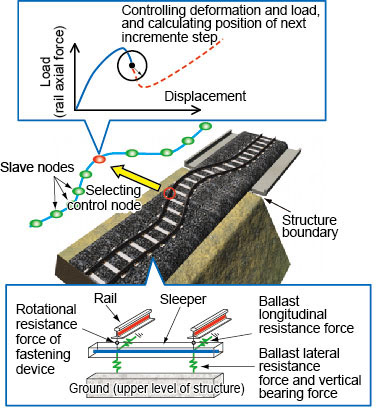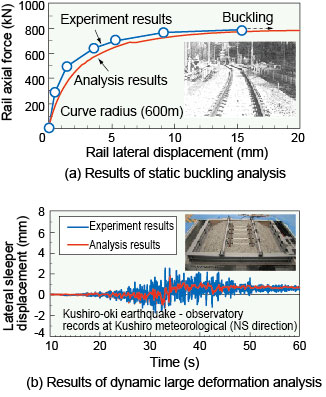9.Analysis method for buckling and large deformation of ballast track
- An analysis method has been developed for evaluating buckling stability and large deformation behaviour in ballast track.
- This method can be used for quantitative assessments under a variety of conditions, such as under the influence of ordinary temperature changes and vibrations duringseismicity.
Quantitative evaluation of buckling stability and deformation of track due to ordinary temperature changes are fundamental to long-rail management, considering a variety of conditions such as track laying conditions and structures. Moreover, in recent years, as progress has been made in the search for countermeasures against derailment and deviation during seismicity, there is a growing need to assess the deformation behavior of ballast track quantitatively.
As such, an analysis method for buckling and large deformation has been developed to quantitatively assess the influence of certain conditions, such as ordinary temperature variation and lateral vibrations during seismicity for ballast track.
The method in question (Fig.1) models a wide range of tracks and structures using 3D FEM modeling. The rails and sleepers are divided into nodes connected by beam elements whereas ballast resistance forces and fastening device properties are represented as non-linear spring elements. In ordinary buckling behavior analysis, rail axial force is added in small increments while deformation behavior is calculated focusing on a nodes displaying the greatest deformation. Deformation of the overall track is found by comparing deformation of other nodes with the node mentioned just above.
Track deformation behavior for analyzing dynamic deformation in case of seismic activity is found by considering the influence of relative displacement in structure boundaries, lateral excitation and track resistance characteristics.
Results of full scale track buckling and excitation tests validated the method as a means of estimating ballast track behavior in the case of buckling and major deformation (Fig.2).

Fig.1 Outline of analytical model
Fig.2 Validation example of the proposed analysis model